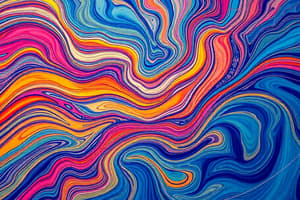Podcast
Questions and Answers
What defines a streamline in a flow field?
What defines a streamline in a flow field?
- It can cross other streamlines without restriction.
- It represents velocity at all particles in the flow.
- It shows the pressure distribution in the fluid.
- The tangent at any point indicates the direction of the velocity vector. (correct)
What is true about the relationship between path lines and streamlines in unsteady non-uniform flow?
What is true about the relationship between path lines and streamlines in unsteady non-uniform flow?
- Path lines and streamlines coincide for all particles.
- Particles don't move along streamlines.
- Path lines and streamlines are identical in appearance.
- Path lines can deviate from streamlines. (correct)
How is velocity described along a streamline?
How is velocity described along a streamline?
- Every point along the streamline has the same velocity magnitude.
- Velocity is defined as the average speed of the fluid over time.
- Velocity at any point can be determined from the pressure distribution.
- Velocity components can vary with respect to the coordinate axes. (correct)
What describes a streak line in fluid dynamics?
What describes a streak line in fluid dynamics?
Which of the following statements about instantaneous streamlines is correct?
Which of the following statements about instantaneous streamlines is correct?
What does the differential equation of the streamline illustrate?
What does the differential equation of the streamline illustrate?
What is a key characteristic of path lines?
What is a key characteristic of path lines?
What is typically true for a fluid particle moving along a streamline?
What is typically true for a fluid particle moving along a streamline?
What characterizes a stream tube?
What characterizes a stream tube?
How is steady flow defined?
How is steady flow defined?
What distinguishes laminar flow from turbulent flow?
What distinguishes laminar flow from turbulent flow?
What is meant by compressible flow?
What is meant by compressible flow?
Which flow type is characterized as irrotational?
Which flow type is characterized as irrotational?
In the context of fluid dynamics, what does a one-dimensional flow imply?
In the context of fluid dynamics, what does a one-dimensional flow imply?
Which statement accurately defines uniform flow?
Which statement accurately defines uniform flow?
What is the consequence of a fluid in a turbulent flow regime?
What is the consequence of a fluid in a turbulent flow regime?
What happens in an incompressible flow concerning fluid density?
What happens in an incompressible flow concerning fluid density?
What does the Reynolds number indicate in fluid flow investigations?
What does the Reynolds number indicate in fluid flow investigations?
Flashcards
Streamline
Streamline
An imaginary line in a flow field where the tangent at any point indicates the velocity vector direction. No flow occurs across a streamline.
Pathline
Pathline
The actual path followed by a specific fluid particle over time.
Streakline
Streakline
The line connecting all fluid particles that have passed through a fixed point.
Kinematics
Kinematics
Signup and view all the flashcards
Steady Flow
Steady Flow
Signup and view all the flashcards
Unsteady Flow
Unsteady Flow
Signup and view all the flashcards
Velocity vector
Velocity vector
Signup and view all the flashcards
Differential equation of streamline
Differential equation of streamline
Signup and view all the flashcards
Uniform Flow
Uniform Flow
Signup and view all the flashcards
Non-Uniform Flow
Non-Uniform Flow
Signup and view all the flashcards
Laminar Flow
Laminar Flow
Signup and view all the flashcards
Turbulent Flow
Turbulent Flow
Signup and view all the flashcards
Compressible Flow
Compressible Flow
Signup and view all the flashcards
Incompressible Flow
Incompressible Flow
Signup and view all the flashcards
Stream Tube
Stream Tube
Signup and view all the flashcards
Discharge (Q)
Discharge (Q)
Signup and view all the flashcards
Study Notes
Kinematics
- Kinematics studies motion without considering forces.
- Velocity is crucial in fluid flow analysis to determine pressure and forces.
Streamlines
- Streamlines are imaginary lines tangent to velocity vectors.
- No flow crosses streamlines.
- A differential equation describes streamlines: dx/u = dy/v = ds/w.
Path Lines
- A path line shows the trajectory of a particular fluid particle.
- It tracks the particle's movement over time.
Streak Lines
- Streak lines trace the path of particles passing a fixed point.
- Dye or smoke are typical tracers.
- In steady flow, streamlines, path lines, and streak lines coincide.
Instantaneous Streamlines
- In unsteady flow, streamlines change with time.
- Instantaneous streamlines depict the streamline position at a specific time.
Stream Tubes
- Streamlines forming a closed curve create a stream tube.
- Fluid cannot cross a stream tube's boundary.
- Fluid entering a stream tube equals fluid leaving.
Flow Classifications
-
Steady/Unsteady: Steady flow has constant properties over time, while unsteady flow changes with time.
-
Uniform/Non-uniform: Uniform flow has constant velocity throughout, while non-uniform flow changes with position.
-
Laminar/Turbulent: Laminar flow is smooth and in layers, while turbulent flow is erratic with eddies.
-
Compressible/Incompressible: Incompressible fluids have constant density, while compressible fluids do not.
-
Rotational/Irrotational: Rotational flow involves particle rotation, while irrotational flow does not.
-
One, Two, and Three-Dimensional Flows: One-dimensional flow varies in one direction, two-dimensional in two, and three-dimensional in three.
Discharge (Rate of Flow)
- Discharge measures fluid quantity per second.
- Liquid discharge is volume per second (e.g., m³/s).
- Gas discharge is often weight or force per second (e.g., kgf/s, N/s).
Studying That Suits You
Use AI to generate personalized quizzes and flashcards to suit your learning preferences.





